
JANUARY 2022
Future Forum Pulse
Leveling the playing field in the hybrid workplace
With new data showing that women, parents, and people of color are spending the least amount of time in the office, leaders must act swiftly to guard against inequity.
Read through the report by clicking the sections below, or download the full report as a PDF.
Future Forum is a consortium focused on building a way of working that is flexible, inclusive, and connected. We conduct research and convene executives to design a people-centered and digital-first workplace. In June 2020, Future Forum began surveying thousands of workers and managers globally on a quarterly basis, asking them a series of questions related to productivity, sense of belonging, and preferred ways of working. This report summarizes the findings of the Winter 2021/2022 Future Forum Pulse, a survey of 10,737 knowledge workers across the US, Australia, France, Germany, Japan, and the UK conducted from November 1-30, 2021.
The end of the “remote versus office” debate
It’s time to move past the “remote versus office” debate. The future of work isn’t either/or—it’s both. Findings from the Pulse survey show that as of November 2021, the majority of knowledge workers have adopted a hybrid work arrangement, spending some time in the office and some time remote.
- Less than one-third (30%) of global knowledge workers are working from the office every day.
- Meanwhile, the percentage of people working in hybrid arrangements has increased to 58% (from 46% in May 2021), as the share of workers who say their teams work exclusively either from home or from the office has declined sharply.
Flexibility is the expectation—and increasingly the norm—for knowledge workers
Consistent with the broad shift to hybrid work, the Future Forum Pulse shows that the vast majority of global knowledge workers now expect to have flexibility in both where and when they work. Desire for flexibility is particularly strong among those who have historically been underrepresented in knowledge work, including people of color, women, and working mothers.
- Seventy-eight percent of all survey respondents say they want location flexibility (up from 76% last quarter), while 95% want schedule flexibility (up from 93%).
- Executives who are concerned about the Great Resignation should take note that among their employees, requests for more flexibility are not “empty threats”—71% of workers who are dissatisfied with their current level of flexibility at work say they are likely to look for a new job in the next year, compared with 58% of total respondents (up from 57% last quarter).
- In the US, 86% of Hispanic/Latinx knowledge workers and 81% of Asian/Asian American and Black knowledge workers would prefer a hybrid or fully remote work arrangement, compared with 75% of white knowledge workers.
- Globally, 52% of women want to work at least mostly remotely compared with 46% of men.
- Fifty percent of working moms report they’d prefer to work from home most or all of the time, as compared to 43% of working dads.
Inequity is a rising priority for leaders
There is a growing concern that “proximity bias” may lead to inequities between remote and in-office employees—and could entrench deeper structural inequities along racial and gender lines.
- In the US, white knowledge workers are spending the most time in the office by a significant margin—as great as 17 percentage points.
- Data from the Pulse shows that people of color, women, and working mothers are opting into flexible work arrangements at higher rates than their peers.
- Globally, 84% of men work in the office all or some of the time, compared to 79% of women. And 75% of working parents work remotely or hybrid, compared to 63% of non-parents.
- The risk of proximity bias is exacerbated by the vastly different preferences of executives and employees. Forty-two percent of executives report they work from the office 3-4 days a week as compared to just 30% of non-executives. And 75% of executives currently working fully remotely report they would prefer to work from the office three or more days a week, as compared to 37% of non-executives.
- Fittingly, proximity bias is now executives’ number one concern with respect to flexible work. Forty-one percent of executives cite the potential for inequities to develop between remote and in-office employees as their top concern (up from 33% last quarter).
Nearly two years into the pandemic, flexibility in both location and schedule is the expectation and (increasingly) the norm among global knowledge workers. Prior to the COVID-19 pandemic, about half of knowledge workers globally worked in the office full-time. But as of November 2021, that percentage had dropped to less than a third (30%) of all knowledge workers.
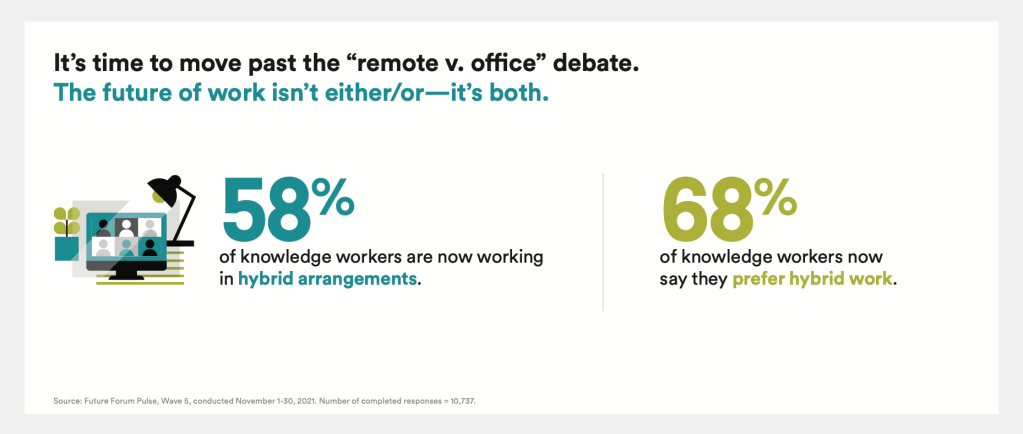
The dominant model is now hybrid, with most knowledge workers working some time in the office and some time remotely. Hybrid work arrangements increased 12 percentage points between May and November of 2021, rising from 46% to 58% of all survey respondents.
And more people want flexibility than ever before. Desire for location flexibility is up to 78% (from 76% last quarter), and desire for schedule flexibility is up to 95% (from 94% last quarter).
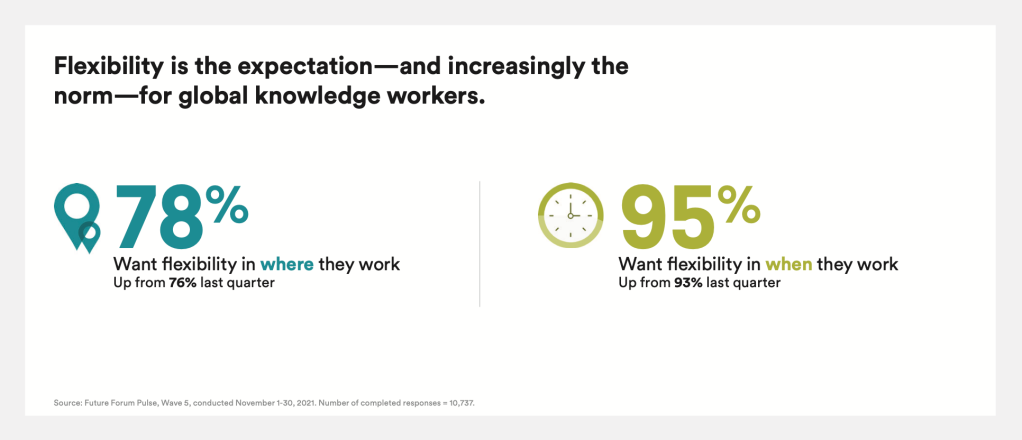
“It’s past time to move beyond the ‘remote versus office’ debate. The future of work isn’t either/or, it’s both,” said Brian Elliott, executive leader of Future Forum.
“A hybrid model can foster a more flexible and inclusive workplace, but only if leaders are intentional about establishing guardrails to ensure all employees have equal access to opportunity and can participate on a level playing field.”
Companies are responding to that demand. Half of survey respondents now say their company offers flexible working hours and 42% offer flexibility in working location.
As employees settle into the new way of working, employee experience scores have improved across the board and are now the highest they’ve ever been since we first started surveying.
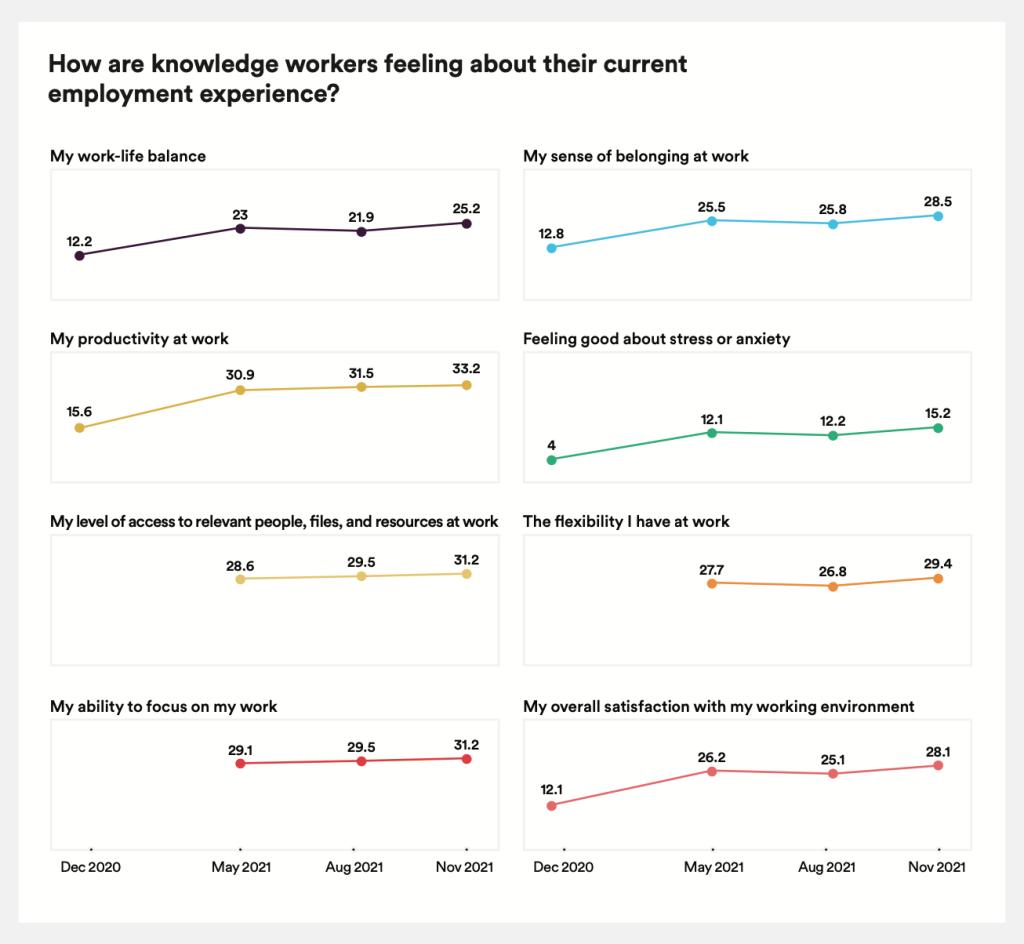
This trend of rising employee experience scores cuts across nearly all demographics and countries. Globally, knowledge workers are polling higher across all eight dimen- sions of our survey, perhaps in part driven by economic growth as well as the fact that COVID-19 transmission rates were receding at the time the survey was administered.
As of November 2021, knowledge workers globally were polling 12% higher than the previous quarter for overall satisfaction with their working environment, 15% higher for work-life balance, and 25% better about work stress and anxiety. US workers are feeling the most positive about their working lives compared to their global peers, followed by the UK, Australia, and Germany. While knowledge workers in Japan are still reporting the lowest employee satisfaction scores globally, Japanese workers have also shown the greatest jump in scores over consecutive quarters—including a threefold increase for overall satisfaction.
Remote and hybrid employees score higher than full-time office workers on all elements of the employee experience, from work-life balance and work-related stress, to measures like sense of belonging at work and value of relationships with coworkers—long a source of concern about remote and hybrid work arrangements.
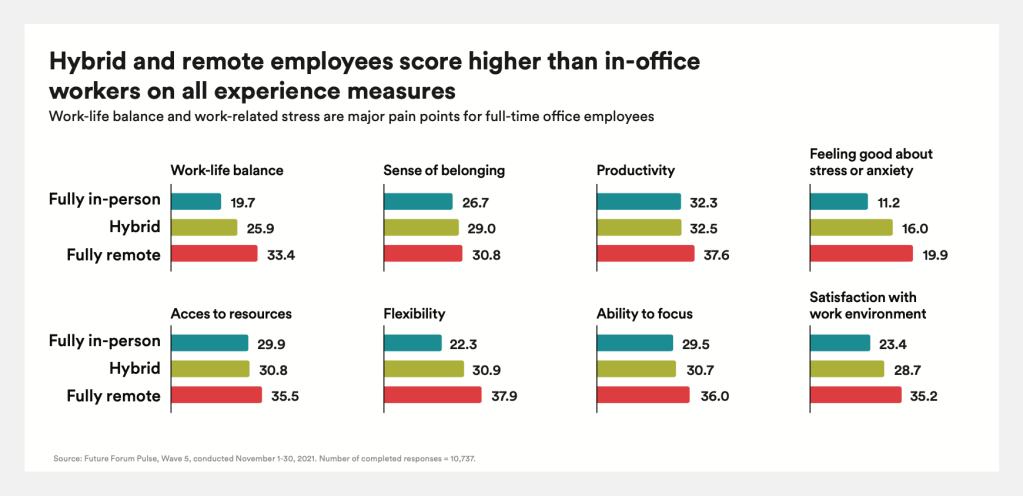
Knowledge workers who work in a hybrid or fully remote environment score significantly higher for work-life balance and flexibility than those working full-time in the office.
They also score significantly higher for productivity; level of access to files, resources, and people; ability to focus; and lower work-related stress and anxiety. Perhaps most surprisingly, they score higher for “sense of belonging at work.”
Fully remote knowledge workers report the highest scores for “overall satisfaction with the working environment.” They’re 50% more satisfied than those working full-time in the office.
In the US, these gains have been driven by sharp increases in the scores of people of color, particularly Black and Hispanic/Latinx knowledge workers. Since May 2021, sense of belonging at work has increased 24% for Black respondents and 32% for Hispanic/Latinx respondents, compared with 5% for white respondents. During this time, agreement with the statement “I am treated fairly at work” has also grown significantly among Black knowledge workers (+21%) and Hispanic/ Latinx knowledge workers (+13%). Notably, while these gains have helped close the employee experience gap, Black respondents still trail behind white respondents on both measures.
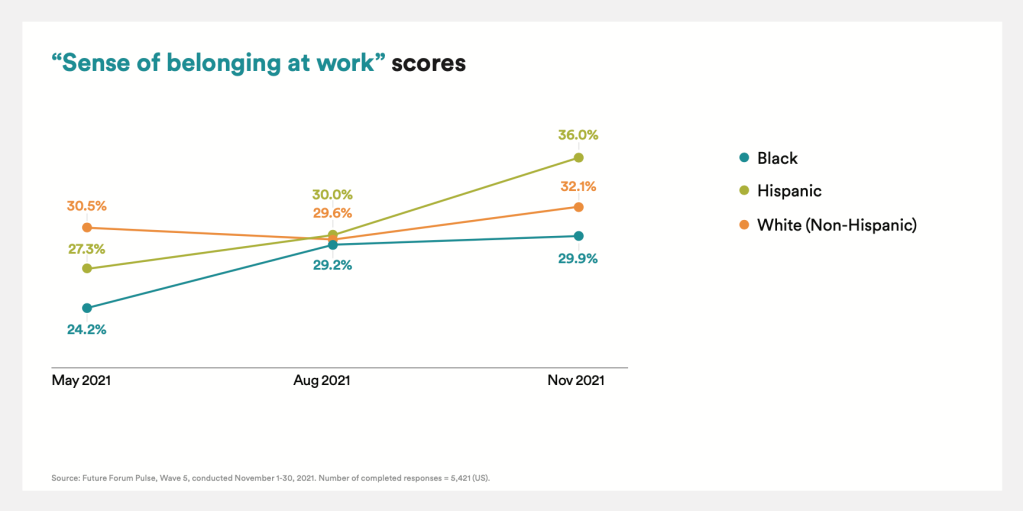
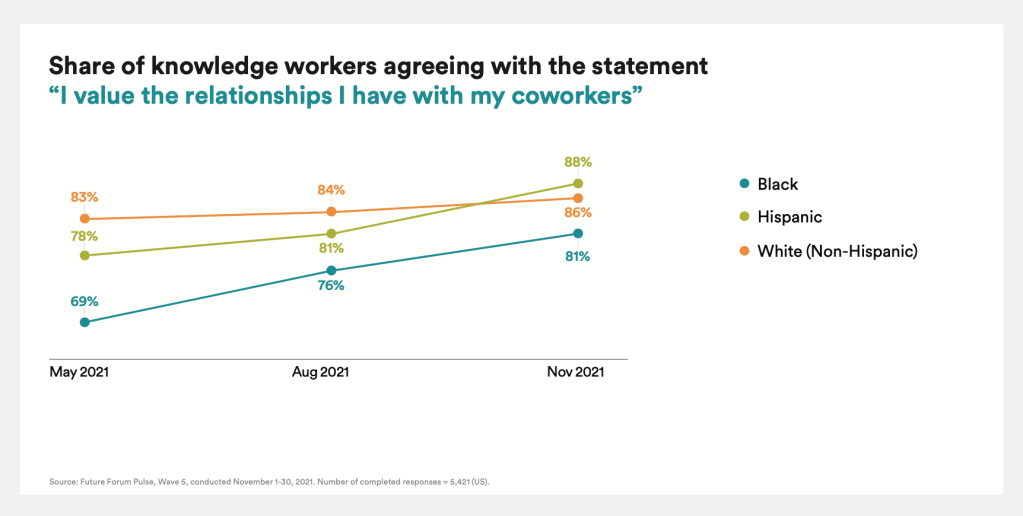
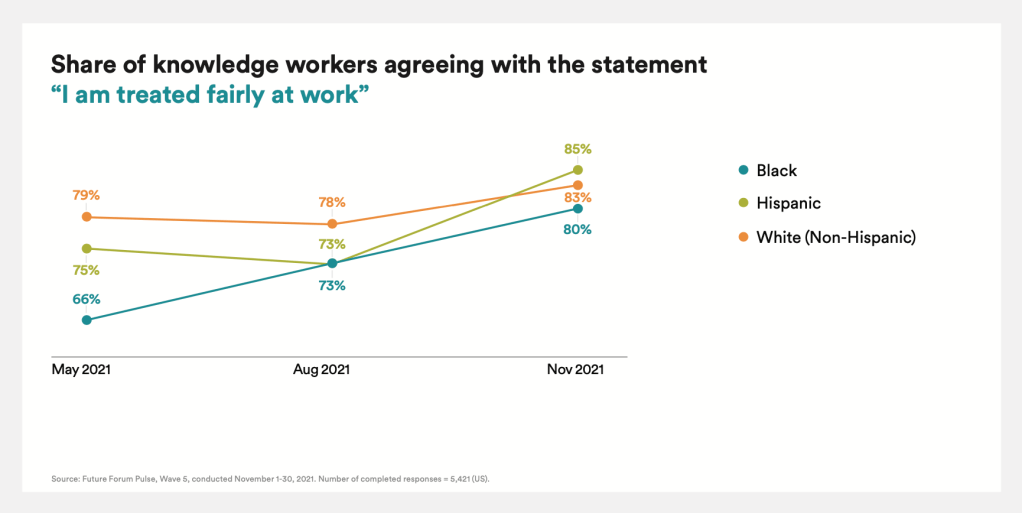
Knowledge workers overall—78%—want location flexibility, up from 76% over previous quarters. More than three in five knowledge workers would prefer a hybrid working arrangement.
Our data shows that people of color, women, and working moms continue to value location flexibility the most. In the US, 86% of Hispanic/Latinx knowledge workers and 81% of Asian/Asian American and Black knowledge workers would prefer a hybrid or fully remote arrangement, as compared to 75% of white knowledge workers.
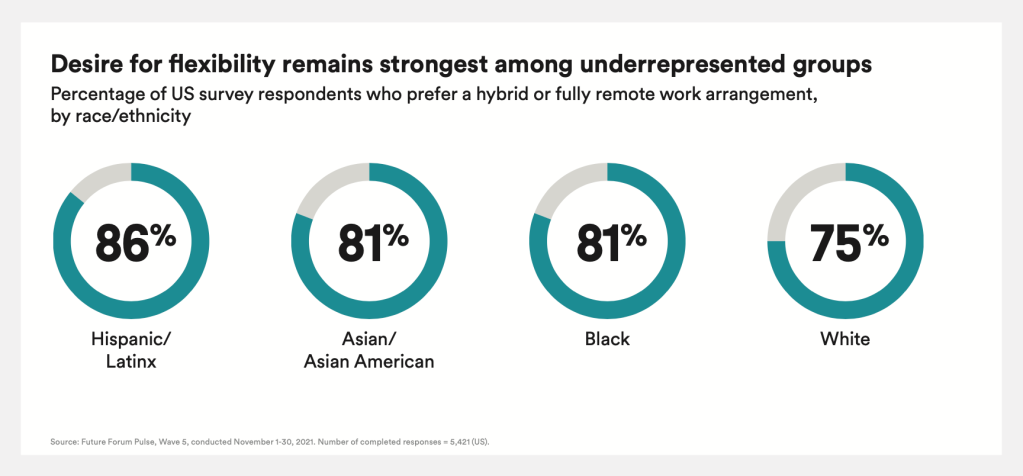
The number of Black knowledge workers interested in working from home full- time has increased each quarter since May, while the opposite is true for white knowledge workers. Overall, white knowledge workers are most interested in returning to the office full-time, as compared to employees of color, and this preference has remained consistent since our surveys began.
Differences are apparent when it comes to gender as well. Globally, 52% of women want to work at least mostly remotely, compared with 46% of men. And 50% of working mothers want to work remotely most or all of the time, compared with 43% of working fathers.
Desire for schedule flexibility is also on the rise—from 93% to 95% of all survey respondents. The sentiment is strongest among Hispanic/Latinx and Black employees, as well as women and working moms. Hispanic/Latinx knowledge workers have made the biggest jump in desire for schedule flexibility, with 71% saying they’d like to work whenever they want “most or all of the time”—a 10% increase over the previous quarter. Black knowledge workers are the most likely to prefer total schedule flexibility, and this trend has remained consistent each quarter.
Working parents are 4 to 5 percentage points more likely than non-parents to prefer no schedule constraints, and this preference has only increased each quarter. Fifty percent of working moms report they’d prefer to work from home most or all of the time, as compared to 43% of working dads. In addition, working moms are 16% more likely than female knowledge workers with no children to prefer total schedule flexibility, leaving working moms vulnerable to being relegated to the “mommy track.”
Concerningly, these preferences are playing out where people are physically working. In the US, white knowledge workers are spending the most time in the office by a significant margin—as great as 17 percentage points. Eighty four percent of Hispanic/Latinx knowledge workers, 76% of Black knowledge workers, and 74% of Asian/Asian American knowledge workers report they’re currently working either remotely or hybrid, as compared to just 67% of white knowledge workers.

Globally, 84% of men report they work in the office all or some of the time, as compared to 79% of women. And 75% of working parents work remotely or hybrid, as compared to 63% of non-parents.
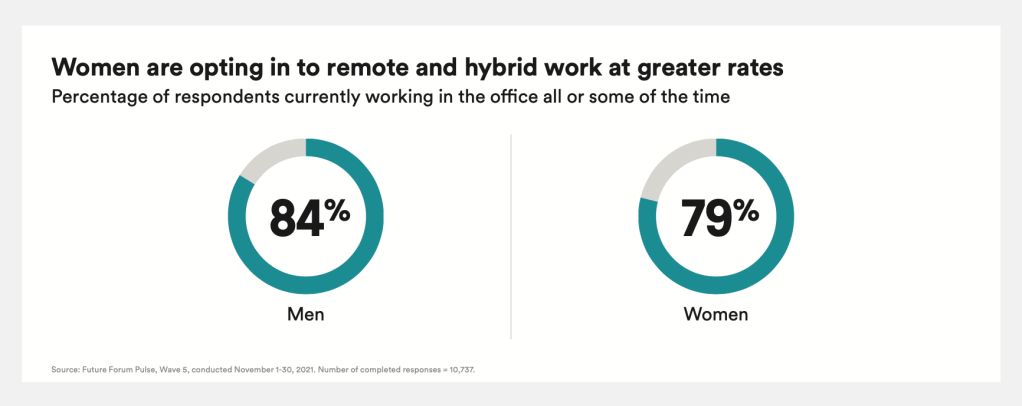
The biggest concern as we enter our third year of the pandemic? The potential for rising “proximity bias”—inequities between co-located and remote employees.
At issue: if underrepresented groups are spending the least amount of time in the office, it could limit their access to professional opportunities—from facetime with the boss to promotions and career mobility.
Executives are taking note, with 41% now citing inequities between those working primarily in person and those working primarily remotely as their top concern and priority when it comes to flexible work—up 8 percentage points from the previous quarter.

“Executives are now acknowledging that there has been a shift in the past two years, and they don’t know how to create equity in this new normal,” said Ella F. Washington, an organizational psychologist and professor at Georgetown University’s McDonough School of Business and the founder of Ellavate Solutions. “This is an opportunity for organizations to reevaluate, refresh, or maybe even start over with some of their management processes, from performance evaluation to diversity and inclusion. No one wants to hear that, but it’s not effective for us to shift over old models to this new way of working. A blank slate can be a real opportunity.”
Yet despite this concern, executives are still spending more time in the office than their employees. Seventy-one percent of executives report that they currently work from the office three or more days a week, compared with 63% of non- executive employees. And this disparity is likely to grow—of those currently working remotely, executives are far more likely than non-executives to say they want to work at least three days a week in the office (75% versus 37%).
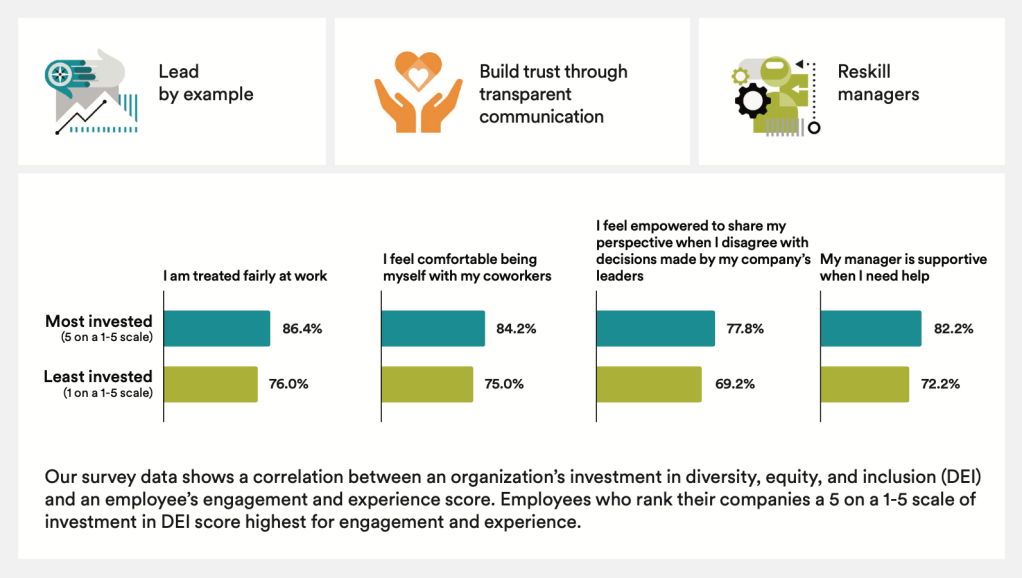
Lead by example
Leaders need to practice what they preach and set the example for the standards they want to uphold. If organizations promote location and schedule flexibility as a company-wide benefit, but managers spend most of their time working in the office, that is likely to lead to double standards that favor the employees—most often white males—who choose to come into the office.
To combat proximity bias and ensure equity between remote and in-office employees, leaders need to intentionally align on principles and guardrails that outline how hybrid work will work at their organizations.
Principles ground an approach in core company values—like inclusivity or equality— while guardrails guide behavior in order to maintain a level playing field for all employees—for example, by limiting the number of days per week that executives spend in the office, or setting a meeting policy that “if one dials in, all dial in.”
Leaders should also evaluate how they can redesign offices to enhance belonging and social connection when employees gather in person.
Build trust through transparent communication
The number of knowledge workers who cite “building a culture of trust” as a concern has increased four percentage points since May of 2021. And in the US, Black and Hispanic/Latinx knowledge workers are most likely to cite this as problem.
Trust is built on transparent communication. And yet while 72% of executives believe they’re being transparent, only 47% of employees agree. This disconnect has real implications for employee experience and retention. Employees who don’t believe their company is being transparent about post-pandemic remote working policies report 20% lower employee satisfaction scores. They’re also more than two times more likely to say they’re definitely planning to look for a new position in the coming year.
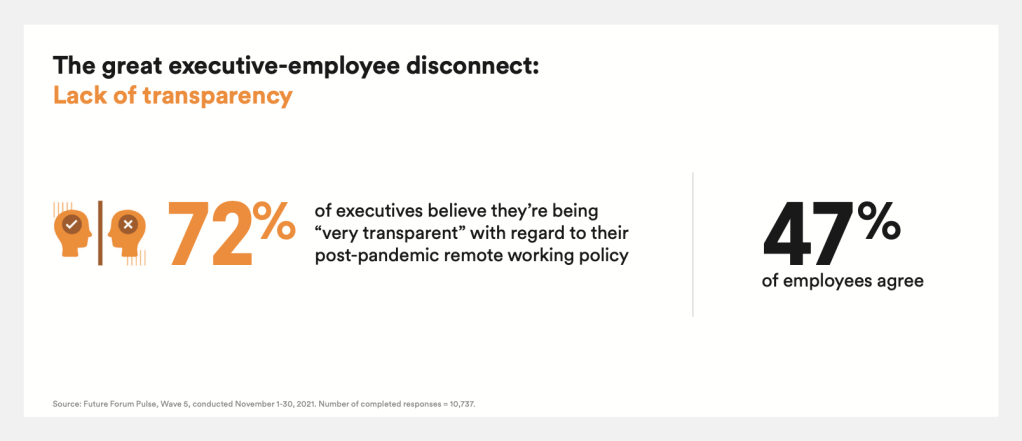
Reskill managers
Globally, one in two survey respondents said they “feel pressure to let colleagues or managers know I am at work and being productive” and this trend has increased quarter over quarter.
And while the share of Black respondents agreeing that their “manager is supportive when needed” has risen significantly since August of 2020 (from 46% to 77%), there’s still a four percentage-point gap between Black knowledge workers and white knowledge workers.
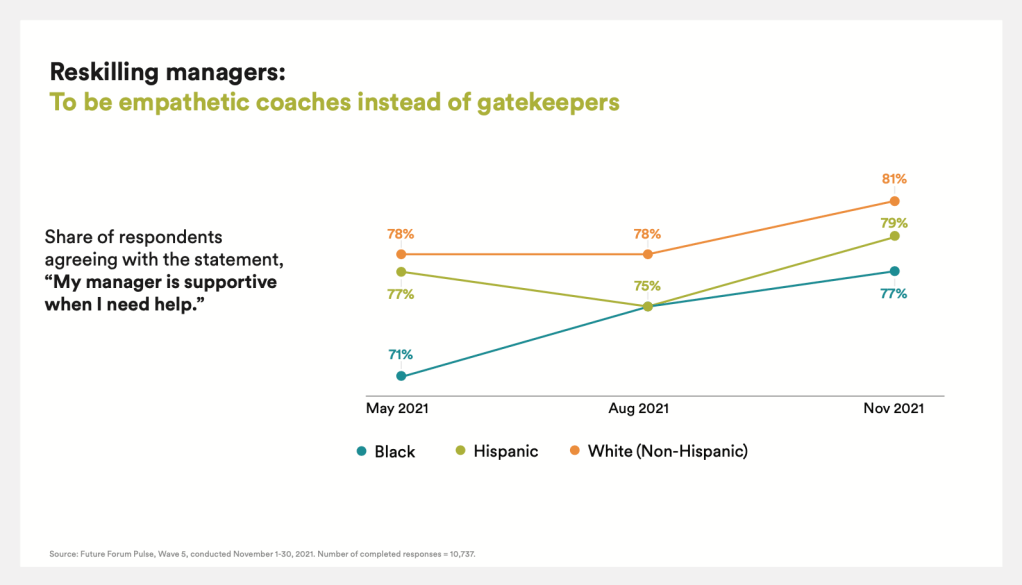
The problem? We’re not trained for this. Managers are buckling under the weight of outdated management expectations that don’t apply to completing complex, interdisciplinary work—let alone building shared purpose among a diverse and distributed workforce looking for connection during unstable times.
The solution? Invest in reskilling your managers from gatekeepers to empathetic coaches and to measure outcomes instead of inputs.
The data from our latest Pulse survey demonstrates that knowledge workers—and in particular people of color, working mothers, and women—are thriving with the rise of newfound location and schedule flexibility. The “remote versus office” debate is over; the future of work is hybrid. But with executives, white knowledge workers, men, and non-parents opting into in-office work at higher rates, leaders who hope to retain top talent and maintain diversity must act swiftly and deliberately to counter the forces of proximity bias. If they don’t, they risk further entrenching structural inequality along racial and gender lines.
Methodology
This Future Forum Pulse surveyed 10,737 knowledge workers in the US, Australia, France, Germany, Japan and the UK between November 1 – 30, 2021. The survey was administered by Qualtrics and did not target Slack employees or customers. Respondents were all knowledge workers, defined as employed full-time (30 or more hours per week) and either having one of the roles listed below or saying they “work with data, analyze information or think creatively”: Executive Management (e.g., President/Partner, CEO, CFO, C-suite), Senior Management (e.g., Executive VP, Senior VP), Middle Management (e.g., Department/Group Manager, VP), Junior Management (e.g., Manager, Team Leader), Senior Staff (i.e., Non-Management), Skilled Office Worker (e.g., Analyst, Graphic Designer).
The Future Forum Pulse measures how knowledge workers feel about their working lives on a five- point scale (from “very poor” to “very good”) across eight dimensions on a scale from -60 (most negative) to +60 (most positive).
10K+
knowledge workers
6
countries